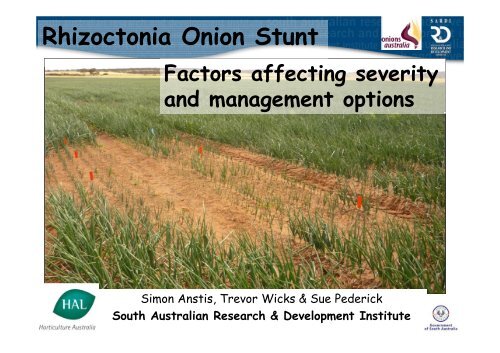Rhizoctonia Onion Stunt
Rhizoctonia Onion Stunt
Rhizoctonia Onion Stunt
You also want an ePaper? Increase the reach of your titles
YUMPU automatically turns print PDFs into web optimized ePapers that Google loves.
<strong>Rhizoctonia</strong> <strong>Onion</strong> <strong>Stunt</strong><br />
Factors affecting severity<br />
and management options<br />
Simon Anstis, Trevor Wicks & Sue Pederick<br />
South Australian Research & Development Institute
<strong>Onion</strong> <strong>Stunt</strong><br />
• Widespread in Mallee, SA &<br />
found Columbia basin, USA<br />
• Causes undersized bulbs and<br />
economic loss<br />
• <strong>Onion</strong>s rotated with cereals<br />
increase <strong>Rhizoctonia</strong><br />
• Root damage similar<br />
to cereals<br />
- spear tips<br />
- sunken cortex
<strong>Onion</strong> <strong>Stunt</strong>- aerial view
<strong>Onion</strong> nurse crops<br />
• Associated with cereal nurse crops<br />
that protect onion seedlings from<br />
sandblast<br />
• Cereal nurse-crops used because:<br />
- rapid germination in cool soils<br />
- easily killed with herbicide<br />
- availability and cost<br />
• Barley/wheat/triticale<br />
• Alternative: above and non-host R.<br />
solani????<br />
• Timing of sowing influences stunt<br />
severity
Timing of sowing:<br />
• Some growers are moving away<br />
from sowing into established<br />
cover crops<br />
• Claim better establishment<br />
• Risk of wind damage<br />
• June/July minimal, varies with<br />
location<br />
• Late plantings prone to windblowing<br />
• <strong>Stunt</strong> risk less, late plantings
<strong>Onion</strong> stunt severity<br />
• Temperature<br />
• Moisture<br />
• Soil type<br />
Method<br />
• <strong>Onion</strong> seedling bioassay<br />
• Mallee onion soils
Effect of Temperature on <strong>Onion</strong> <strong>Stunt</strong><br />
22 C<br />
15 C<br />
Con<br />
AG 8 Con<br />
AG 8
Soil moisture and stunt severity<br />
Increasing soil moisture increases plant growth in the presence of<br />
300<br />
<strong>Rhizoctonia</strong> solani AG8<br />
250<br />
Dry Wt/pot (mg)<br />
200<br />
150<br />
100<br />
50<br />
Lsd (0.05) 39.4<br />
%WHC<br />
25<br />
50<br />
75<br />
0<br />
0 1 3<br />
<strong>Rhizoctonia</strong> propagules/pot<br />
<strong>Onion</strong> seedling growth in 5 soil types at different<br />
moisture
<strong>Onion</strong> <strong>Stunt</strong> across different soils<br />
• Over<br />
different soils<br />
proportion of<br />
coarse sand<br />
generally<br />
related to<br />
stunt severity<br />
500<br />
400<br />
300<br />
• Other<br />
parameters<br />
variable pH,<br />
mineral<br />
nutrients<br />
200<br />
100<br />
0<br />
Dry Wt (mg/pot)<br />
Coarse sand fraction<br />
69.0%<br />
86.5%<br />
49.6%<br />
72.4%<br />
Caloote Kea Keb Tailem Bend<br />
No pathogen<br />
R. solani
Soil Fumigants<br />
• Both Metham &<br />
TeloneC35 reduce<br />
soil inoculum
<strong>Onion</strong> metham fumigation response<br />
Fumigated strip through non-fumigated plot
<strong>Onion</strong> crop 2 seasons after fumigation<br />
Non-stunted areas:<br />
45 ± 21 pg AG 8 DNA/g soil<br />
• Aerial photograph<br />
onions 2 years<br />
after metham<br />
• Patches of onion<br />
stunt<br />
Patches:<br />
448 ± 58 pg AG 8 DNA/g soil
<strong>Onion</strong> <strong>Stunt</strong>: Case Study<br />
• Site preparation:<br />
• Deep ripping<br />
• Clay spreading<br />
• Deep cultivation<br />
• Levelling<br />
• Compost, lime<br />
Time of<br />
sampling<br />
R. solani<br />
pg DNA/g<br />
Before 88 ± 18<br />
After - with<br />
prep.<br />
9.9 ± 1.4<br />
After - no prep. 135 ± 22<br />
• Pathogen reduction with pivot preparation
Pivot preparation<br />
• Negligible stunting<br />
observed in final<br />
crop<br />
• Some drainage<br />
problems<br />
• Not available to all<br />
growers<br />
• Deep profile enabled<br />
this type of soil<br />
preparation<br />
• Significant cost but<br />
disease control<br />
made up for<br />
expenditure
Beneficial microbes<br />
Bacillus, Streptomyces, Trichoderma, Aspergillus<br />
based formulations evaluated in field and pot<br />
experiments<br />
• Variable response<br />
– growth of diseased plants never completely restored<br />
<strong>Onion</strong> seedlings transplants<br />
• Seedling roots soaked in fungicide solutions or Trichoderma spore<br />
suspensions<br />
• Transplanted into stunted patches<br />
• 4 weeks assessed for height, 16 weeks bulb width and weight
Seedling transplants<br />
Biological treatments more effective than chemical treatments<br />
Plant weight (g) / bulb width (cm)<br />
25<br />
20<br />
15<br />
10<br />
5<br />
0<br />
Weight<br />
Width<br />
Control Amistar Rizolex Plantmate T. harzianum<br />
Trichoderma based<br />
treatments
Fungicide evaluation<br />
• Laboratory and glasshouse studies<br />
• Field evaluation<br />
Experimental seeder and chemical injection machinery
Fungicide response<br />
• Response to soil<br />
fungicide application<br />
• 10 weeks after sowing<br />
until plant maturity<br />
• Up to 50% increase bulb<br />
wt per m seed row<br />
Treated<br />
rows
Management options<br />
<strong>Onion</strong> stunt can be managed by:<br />
• Soil working and pivot preparation<br />
• Timing of nurse crop sowing with regards<br />
to early or late planting<br />
• Fumigation<br />
• Fungicide application






![[Compatibility Mode].pdf](https://img.yumpu.com/27318716/1/190x135/compatibility-modepdf.jpg?quality=85)









